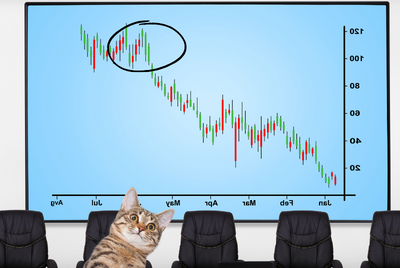What Is a Dead Cat Bounce?
This colorful term is used to describe a technical phenomenon that occurs during a significant market downtrend. After weeks or even months of grinding lower, asset prices appear suddenly and inexplicably to change direction and spring back to life.
Puzzled traders wonder, is this the big turnaround they have been desperately awaiting? Has the wind really changed? Also known as a “sucker’s rally,” the move can take anyone by surprise.
On one hand, if participants are slow to react, they risk losing a grand opportunity. On the other, most such rallies turn out to be no more than a flash in the pan, and traders who commit serious capital pile up further losses when the market resumes its downtrend.
Markets do not plunge in a straight line; multiple small trend reversals are an element of normal fluctuation. So, how can you tell the difference? Why does it happen? And what is the appropriate course of action?
The hallmarks
Is the feline bouncing or is it a genuine bullish reversal, such as the historic moment on March 6, 2009? That day, the S&P touched 666 after a long and brutal descent and finally bottomed, eventually rising fivefold. The answer is there is no sure way to confirm when the market has reversed until well after the fact.
If the cat is bouncing, three clues will emerge:
- A sustained slow and steady downtrend will already be well underway.
- Prices will recover over a brief window.
- A new price level will be established, breaking beneath the previous lows.
The pattern may apply to individual securities or to an entire market or sector. These bounces do often seem to take place at 52-week lows or thereabouts, possibly because the round time interval has focused traders’ attention. Seeing a newly affordable price may spark their interest.
The drivers are usually based on sentiment. (The essence of a dead cat bounce is that it is not based on fundamentals, although some investors may scramble to “find” one.) As the market tacks, value investors take heart and begin to build new positions. At the same time, momentum players perceive oversold levels, which prompts them to buy alongside.
If investors still want to participate in a rally that may turn out to be short-lived, they should set tight trailing stop loss orders as a protection against being sucked down again.
Snapshots from history
In a painful example of a dead cat bounce, investors witnessed several false rallies in 2008 during the great financial crisis before the final throes in March 2009. Another more recent crash in March 2020, triggered by COVID-19 panic, illustrates a classic bounce.
Just prior to the pandemic, Wells Fargo was changing hands at $53 per share. When the virus news struck, the prospect of defaulting loans sent the price down to $26.
Then, the cat bounced. One possible driver was the announcement of the government’s first economic stimulus program. The price enjoyed a brief recovery to almost $34, soon followed by further losses, taking it down to under $23.
The notoriously volatile cryptocurrency market offers numerous examples. In early 2022, bitcoin experienced a short reprieve in the midst of a long bear stretch, having peaked in November 2021 at $68,000. It paused in January 2022 for a short ride back to $43,000 before regressing again.
The bounce told investors little about the further losses to come. Did we learn anything? Only perhaps that cats may indeed have nine lives.
Your own capital may be more vulnerable than long-lived cats! Before making an investment, be sure to discuss your goals with your financial adviser.
Do you have questions?
Count on your experienced team at Ericson, Scalise & Mangan, PC to provide you with sound guidance for your Estate Planning, Elder Law, Real Estate, Probate, Trust & Estate Administration, and other legal needs. For assistance, contact us today at (860) 229-0369, or email us at info@esmlaw.com.

